
Thomas Carlyle was a Scottish essayist, historian, and philosopher. A leading writer of the Victorian era, he exerted a profound influence on 19th-century art, literature, and philosophy.

Edward Hodges Baily was a prolific English sculptor responsible for numerous public monuments, portrait busts, statues and exhibition pieces as well as works in silver. He carved friezes for both the Marble Arch and Buckingham Palace in London. His numerous statues of public figures include that of Horatio Nelson on top of Nelson's Column and Charles Grey, 2nd Earl Grey on Grey's Monument in Newcastle upon Tyne. Throughout his career Baily was responsible for creating a number of monuments and memorials for British churches and cathedrals, including several in St Paul's Cathedral.
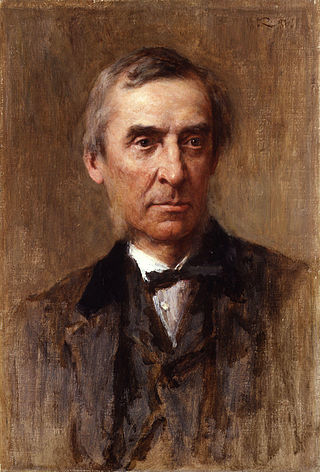
James Anthony Froude was an English historian, novelist, biographer, and editor of Fraser's Magazine. From his upbringing amidst the Anglo-Catholic Oxford Movement, Froude intended to become a clergyman, but doubts about the doctrines of the Anglican church, published in his scandalous 1849 novel The Nemesis of Faith, drove him to abandon his religious career. Froude turned to writing history, becoming one of the best-known historians of his time for his History of England from the Fall of Wolsey to the Defeat of the Spanish Armada.

Sir William Hamo Thornycroft was an English sculptor, responsible for some of London's best-known statues, including the statue of Oliver Cromwell outside the Palace of Westminster. He was a keen student of classical sculpture and was one of the youngest artists to be elected to the Royal Academy, in 1882, the same year the bronze cast of Teucer was purchased for the British nation under the auspices of the Chantrey Bequest.

The National Portrait Gallery (NPG) is an art gallery in London housing a collection of portraits of historically important and famous British people. It was arguably the first national public gallery dedicated to portraits in the world when it opened in 1856. The gallery moved in 1896 to its current site at St Martin's Place, off Trafalgar Square, and adjoining the National Gallery. It has been expanded twice since then. The National Portrait Gallery also has regional outposts at Beningbrough Hall in Yorkshire and Montacute House in Somerset. It is unconnected to the Scottish National Portrait Gallery in Edinburgh, with which its remit overlaps. The gallery is a non-departmental public body sponsored by the Department for Digital, Culture, Media and Sport.

Sir Joseph Edgar Boehm, 1st Baronet, was an Austrian-born British medallist and sculptor, best known for the "Jubilee head" of Queen Victoria on coinage, and the statue of the Duke of Wellington at Hyde Park Corner. During his career Boehm maintained a large studio in London and produced a significant volume of public works and private commissions. A speciality of Boehm's was the portrait bust; there are many examples of these in the National Portrait Gallery. He was often commissioned by the Royal Family and members of the aristocracy to make sculptures for their parks and gardens. His works were many, and he exhibited 123 of them at the Royal Academy from 1862 to his death in 1890.

Sir John Robert Steell was a Scottish sculptor. He modelled many of the leading figures of Scottish history and culture, and is best known for a number of sculptures displayed in Edinburgh, including the statue of Sir Walter Scott at the base of the Scott Monument.
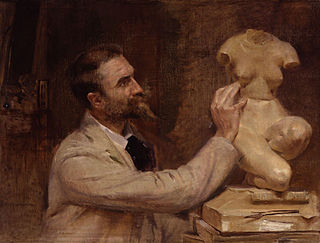
Edward Onslow Ford was an English sculptor. Much of Ford's early success came with portrait heads or busts. These were considered extremely refined, showing his subjects at their best and led to him receiving a number of commissions for public monuments and statues, both in Britain and overseas. Ford also produced a number of bronze statuettes of free-standing figures loosely drawn from mythology or of allegorical subjects. These 'ideal' figures became characteristic of the New Sculpture movement that developed in Britain from about 1880 and of which Ford was a leading exponent.
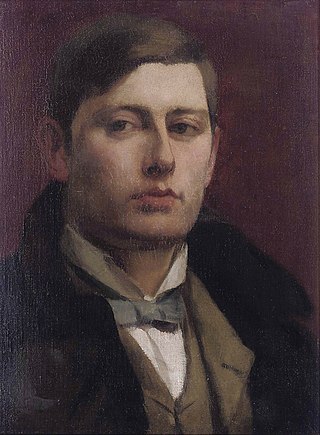
Sir George James Frampton, was a British sculptor. He was a leading member of the New Sculpture movement in his early career when he created sculptures with elements of Art Nouveau and Symbolism, often combining different materials such as marble and bronze in a single piece. While his later works were more traditional in style, Frampton had a prolific career in which he created many notable public monuments, including several statues of Queen Victoria and later, after World War I, a number of war memorials. These included the Edith Cavell Memorial in London, which, along with the Peter Pan statue in Kensington Gardens are possibly Frampton's best known works.

Sir Edgar Bertram Mackennal, usually known as Bertram Mackennal, was an Australian sculptor and medallist, most famous for designing the coinage and stamps bearing the likeness of George V. He signed his work "BM".

The statue of Queen Victoria by Joseph Edgar Boehm stands on College Green, Bristol, England. It is Grade II listed.

Alexander Munro was a British sculptor of the Pre-Raphaelite movement. He concentrated on portraiture and statues, but is best known for his Rossetti-influenced figure-group Paolo and Francesca (1852), which has often been identified as the epitome of Pre-Raphaelite sculpture.
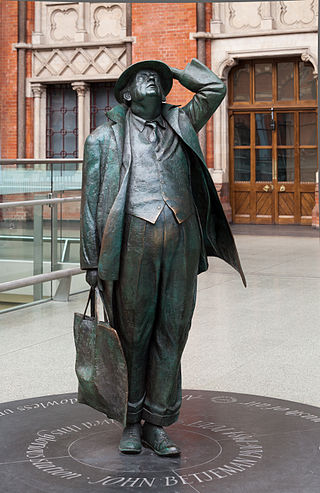
Martin Jennings, FRBS is a British sculptor who works in the figurative tradition, in bronze and stone. His statue of John Betjeman at St Pancras railway station was unveiled in 2007 and the statue of Philip Larkin at Hull Paragon Interchange station was presented in 2010. His statue of Mary Seacole (2016), one of his largest works, stands in the grounds of St Thomas' Hospital in central London, looking over the Thames towards the Houses of Parliament.
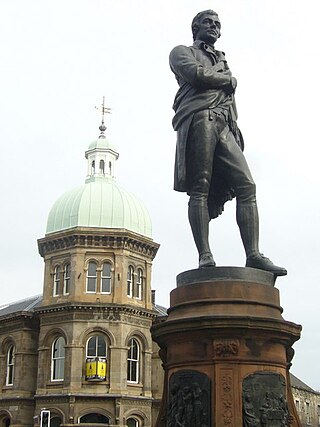
David Watson Stephenson was a Scottish sculptor, executing portraits and monuments in marble and bronze.

The Thames Ditton Foundry was a foundry in Thames Ditton, Surrey, which operated from 1874 to 1939 and which under various owners produced numerous major statues and monuments as one of the United Kingdom's leading firms of bronze founders.

The Memorial to Arthur Sullivan by William Goscombe John stands in Victoria Embankment Gardens in the centre of London. It was designated a Grade II listed structure in 1958.

William John Seward Webber was an English sculptor who created civic statuary, and busts of national heroes and local worthies, in marble. He sculpted the statue of Queen Victoria for the Jubilee Monument in Harrogate, North Riding of Yorkshire, England in 1887. An early success was his Warrior and Wounded Youth group of 1878, executed while he was still a student. His busts include portraits of the Duke of Clarence, John Charles Dollman, Henry Phillpotts, John Bowring, John Ruskin, Richard Jefferies, Alfred, Lord Tennyson, Charles Darwin, Walter Scott, Thomas Carlyle, Robert Burns and Thomas Holroyd.

Thomas Carlyle's Birthplace is a house in Ecclefechan, Dumfries and Galloway, Scotland, UK, in which Thomas Carlyle, who was to become a pre-eminent man of letters, was born in 1795.

The Ruskin Monument is a memorial to John Ruskin located on the edge of Derwentwater in the English Lakes at Friars' Crag, Keswick, Cumbria. It was erected on 6 October 1900, shortly after his death, largely through the efforts of Hardwicke Rawnsley.
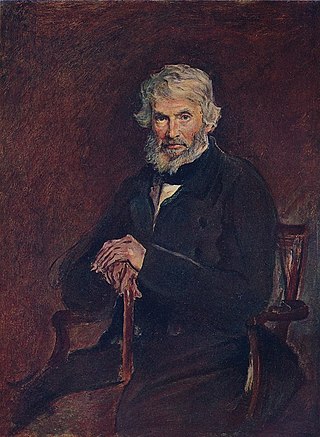
Thomas Carlyle is an unfinished portrait of the Scottish essayist, historian and philosopher of the same name by English Pre-Raphaelite painter John Everett Millais in 1877.


























